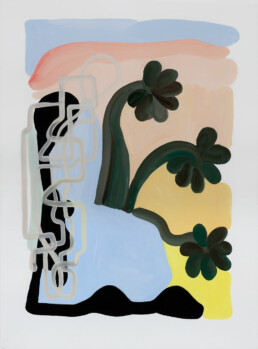Presentation
Since the beginning of her career in the mid-1990s, Marielle Paul has developed the universe she had to, eluding the “what to do” of dominant trends then in vogue in the artistic landscape. Starting modestly with three colours of gouache and two brushes on “child-size” formats (24 x 32 cm), she worked on concentrates, with a landscape-inspired image placed in the center of the sheet. The compositions are dense but simply titled: the month of the creation of the work and a number. The impression is that of a formalised landscape: a juxtaposition of archetypes – rocks, fields, bushes, buildings, trails, clouds – which, added together, communicate the idea of a whole identified as a “landscape.” […]
Marielle Paul uses an open language in which recognisable, formal, formless, and unknown elements enter into free association. Like a poem whose words and interlines widen and shift the meaning, her works produce new imaginations and possibilities. Her inspiration derives from multiple sources: readings, journeys, impressions or fleeting ideas…
Marielle Paul’s favourite technique is gouache on paper – a beautiful, matte, unctuous material, rich in pigments. She works it in flat tints or with a brush loaded with a range of colours which are revealed by the application on the paper. Her discovery of lithographic ink a few years ago was a revelation. The subtle variations of grey and black and ink’s potential for overlays and transparencies has added a new dimension to her world.
Calepin, the title of Marielle Paul’s first exhibition at the Galerie Maria Lund, refers to calepinage – a layout sketch developed to prepare and catalogue the cutting and laying of stones, a coating, or even the joints to be drawn. The title therefore refers to the structure and integration of different elements, but also to a small personal notebook, the calepin, in which to write anything and everything, higgledy-piggledy and without hierarchy. With the series of Mosaïques, Marielle Paul carried out a playful, somewhat mischievous calepinage. These walls with Aztec overtones are composed of very diverse elements and moreover are equipped with legs! The rigour of calepinage has been put of out joint: the Mosaïques wander or rotate on themselves like treadmills… Nouvel horizon (New Horizon), as the name suggests, features paintings articulated around a horizontal line which separates two territories with contrasting hues. Botanical motifs or “electrical” vibrations with assertive graphics develop above these planes of colour. Their dynamism brings about movement and temporality. […]























